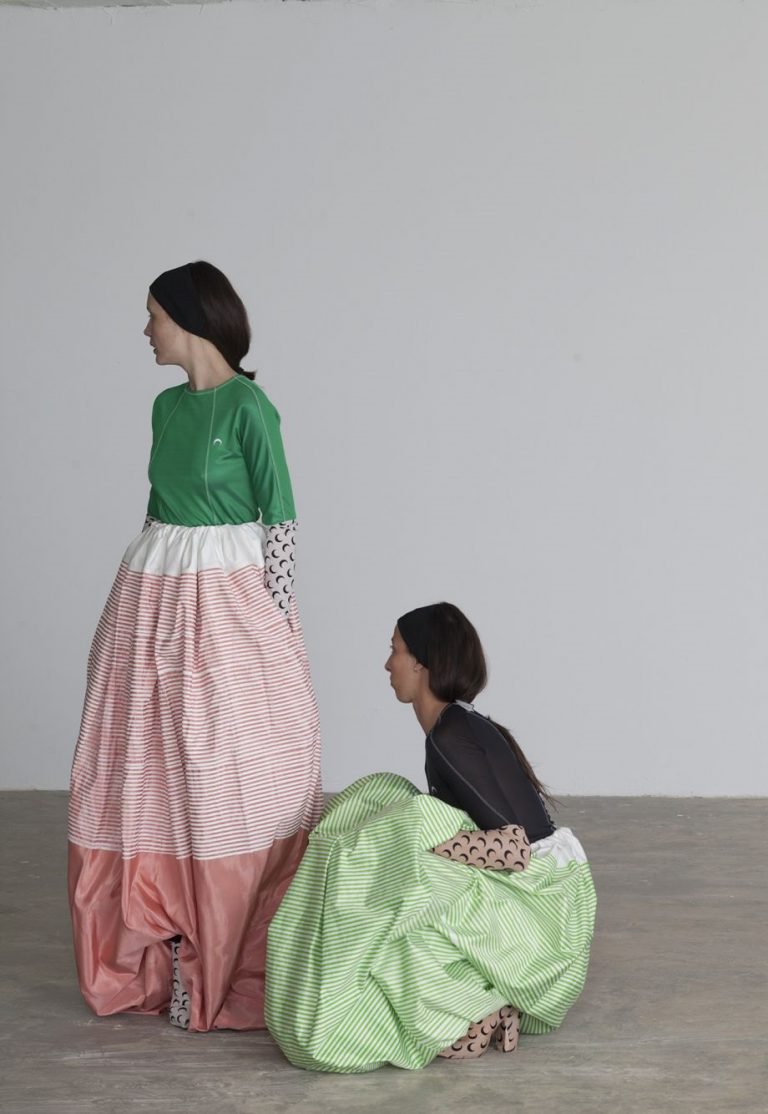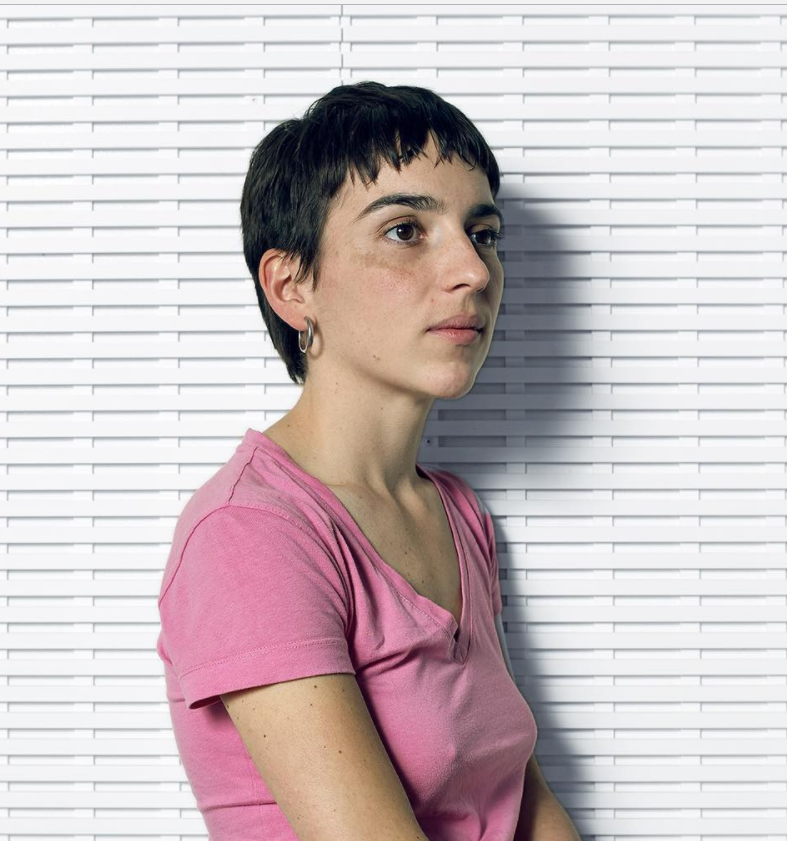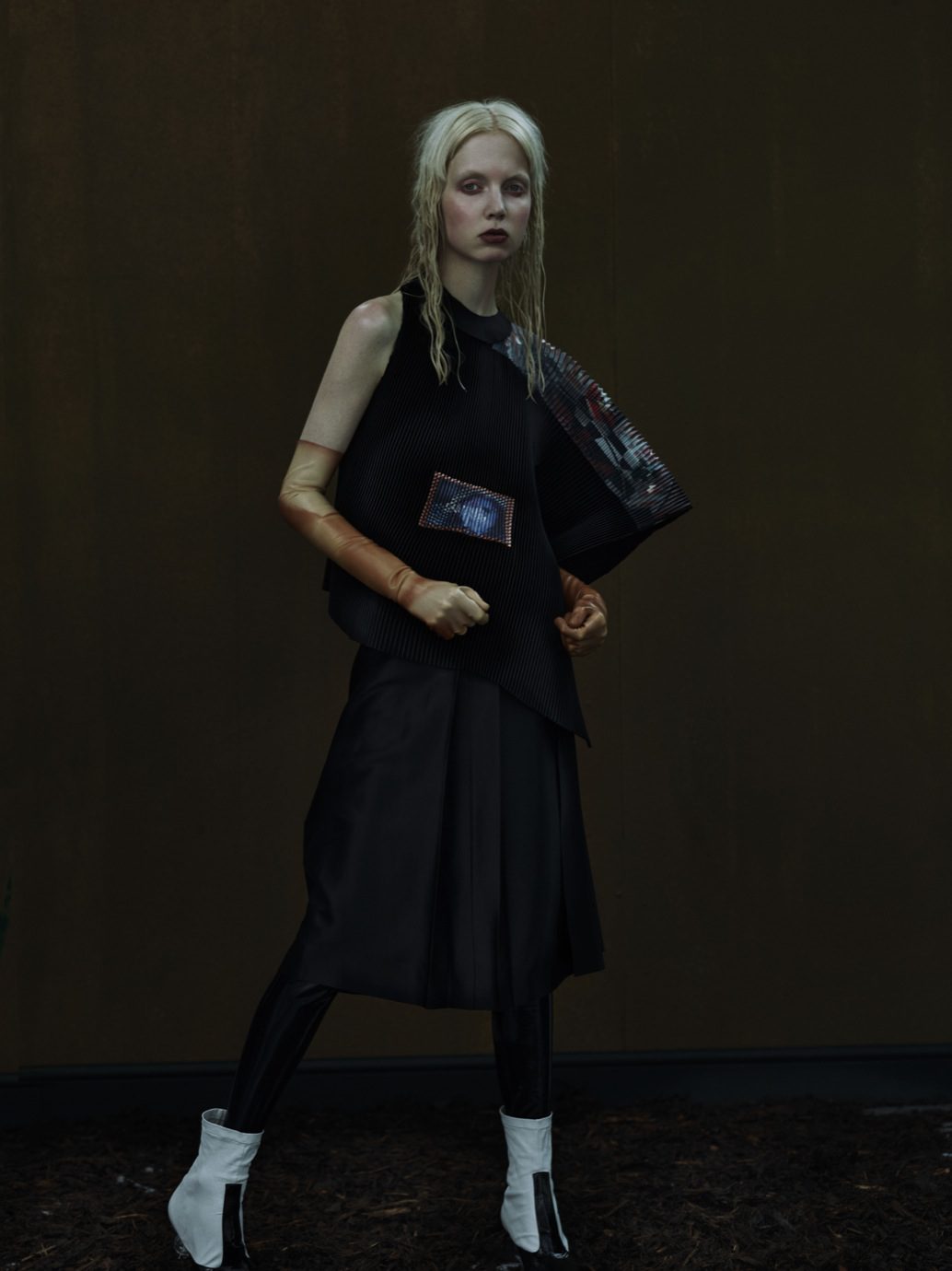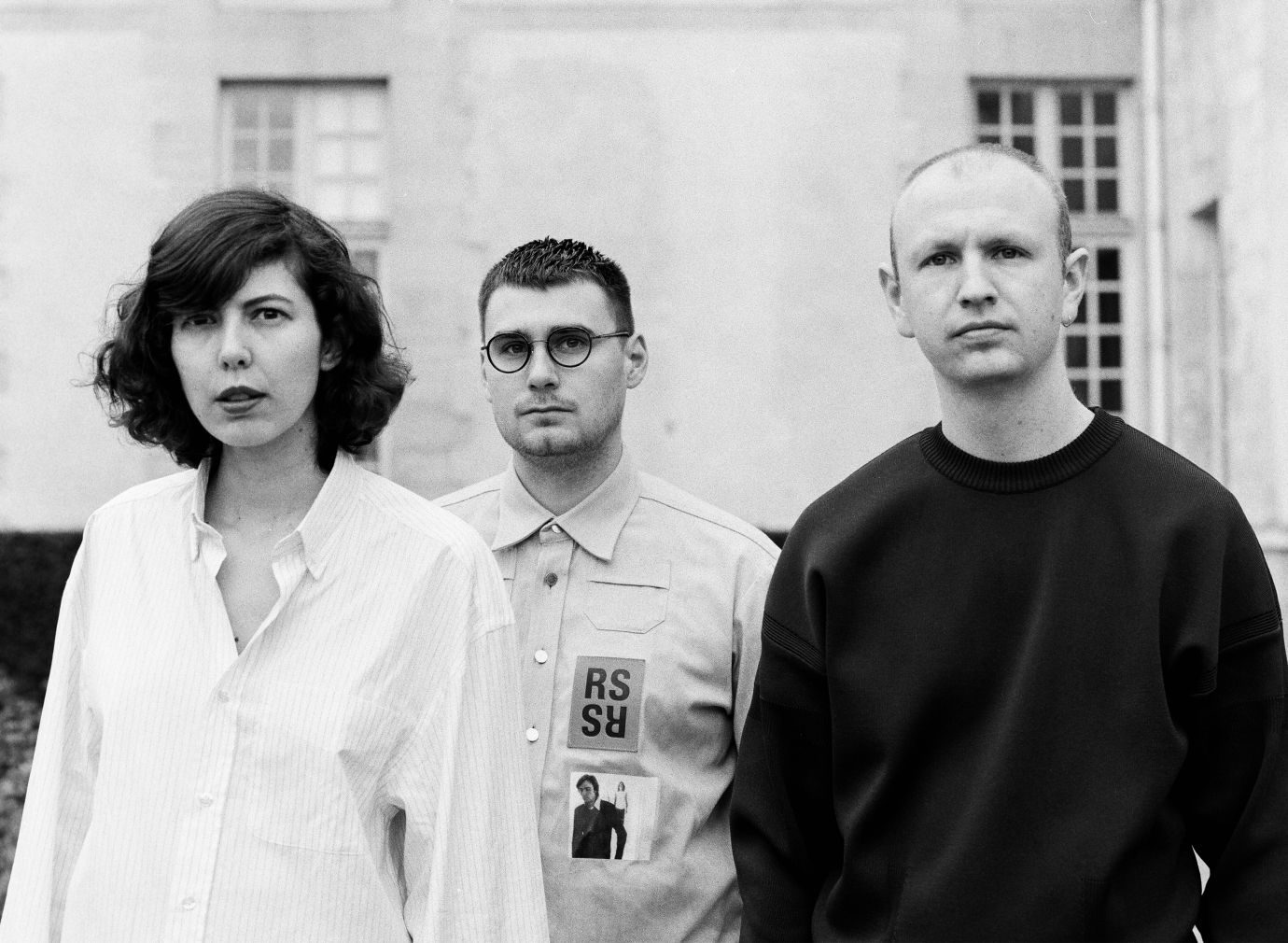Russian fashion designer Tigran Avetisyan met Marine before sunset, on the terrace of a appropriately named Parisian café, to find out more about the young winner.
I read that you were born in France, in a small town in the middle of nowhere?
Yes, it was a really green space, there was no big city around, and it wasn’t really fashionable.
Why fashion? How did you discover it? You said you were in an art school?
I had a lot of interest in the collection of garments. I was really into vintage. Even then, I never went to any shop with new garments. My grandfather was a collector. He had a weird way of doing it – everything was put on a board, like a proper collector. So maybe I was doing similar things with garments, because I learned it from him. Basically, I was buying everything I could find in small markets. Of course, I was living on the countryside where you have Emmaus [a French charity shop] and stuff, so my first relation with fashion started like that.
Then I moved to Creuse, when I was thirteen, another small town not too far from me, two hours from my parents’ house, to pursue my studies in art because there wasn’t an art school where I was living. And after that I thought I should study design. During the course you choose the bits you like basically, and for me it was fashion. It was interesting, and it came quite naturally. I was never doing Illustrations, I was more interested in real things, like ‘today I dress like that,’ and I liked to dress my sister, and play with that.
Were you sewing already by then?
A bit, but not too much. I think it was more about styling, and cutting pants. It was not difficult. After that, I went to the south of France, to Marseille, where I got a technical fashion ‘brevet’. It’s a two year course, and after those two years I thought that it had been quite classical… I didn’t know anything. In the French approach it is more about explaining what you do, rather than doing something.
Theory not practice.
Exactly. And then I went to Belgium and I saw the work at La Cambre. I thought that it would work for me because by then I was already working with volumes. I was experimenting, trying things on people, and that was where it started. And La Cambre is quite a technical school, so you learn about the intricacies of garments, such as pockets. You have to be passionate about it, otherwise you can’t take it.
What was the teaching style like? Because in CSM, you are just given a brief, and then for two or three weeks you do whatever you want with it, and afterwards you return. Is it similar?
The first year was about experimentation, and about what you can do with your hands. So I learned about how to make volumes, and was given lots of freedom with whatever I wanted to do, whilst they also showed you techniques. When you are starting out at eighteen years old, you are like – okay, I want to make this, but how? And by experimenting you learn a lot. Second year is more about detail, like the inside pocket. And you make your first collection… sort of. Now that I know about fashion I wouldn’t call it a collection, but at least I was trying to make it coherent! [Laughs]
And then in the third year you do menswear, so you learn more about pattern, flat pattern, and all the logic that goes with it. Then you have the fourth and the fifth year. It’s quite a long time to study. In the last two years you make your collection, so you are really free, and in those two years you see one teacher a week, not even, and you use all the skills that you have learned before to make something. Thinking about the process, when you learn about making something with your hands you try to find a way to do it yourself, and find your own attitude. So it was there that I made my collection, 15-21. It was the first one, and after that I made Radical Call For Love. They are quite different, but in terms of the process, they follow the same steps. 15-21 is kind of merging primitive Flemish painting and daily life. Things are made with tape, and the collection thinks about pleats in another way.
Before you even went to La Cambre, did you know of any other schools? Did you go there specifically because you knew how the process works?
I tried Antwerp at the time, but my English was really bad. I could not go to Saint Martins because I didn’t have the money, to be honest. I didn’t want to be in Paris because I already had experience in the south and I thought I was missing something, the long courses where you really learn. So I thought, why not? It’s not too far, it’s also free, cheap. Of course, Antwerp is more about illustrations – you have two days of competitions, and you go there and you have to draw. I mean, I was quite bad… not bad, but… yeah, maybe bad… because I was about making something with my hands. And then when I arrived in La Cambre the experience was really different. In Antwerp my English was not so good, and my drawing was not so good, so then of course it didn’t work. Then at La Cambre they speak French, and the competitions were about draping and making weird shapes, so then it worked.
Did you do a placement year? I know that you’ve done a lot of internships, at Margiela, Dior and McQueen.
Yes, and I did even more, because when I was in Marseille in the summer I had a lot of time off so I was just going and working for people. Such as Fred Sathal, this girl that worked in the nineties in couture, who is now showing up again, strangely, who embroiders a lot. She has a really weird perspective, and has her own atelier – it was quite small. Then I worked for On Aura Tout Vu, also a really small thing, and then I worked for Annemie Verbeke. Then I worked for Alexander McQueen, and of course the more experience you have, the more you can get. After that I worked for Maison Margiela, which was a great experience – this was before Galliano arrived – and after that I was at Balenciaga, and I’m still working there.
I did four internships myself and I learned so much that I did not learn at school. Was it the same for you? And which house was the most beneficial?
Yes. The best one for me was Maison Margiela. At Alexander McQueen I had a hard time, London is not Paris…
It’s a hard place to be…
It’s quite hard, and I was really poor so I was living far from the centre. After that I travelled around the Balkans and questioned myself – is this really what I want to do?
Ah okay, so it was kind of a stressful experience?
Yes. Then I went to Maison Margiela with Matthieu Blazy, where I worked for the artisanal line and for ready-to-wear, and this was a really great experience. I was given a lot of responsibility, and I was around people that are really passionate, in an atelier made of the same people who had once worked with Martin. It’s a family, so you share your experiences. I realised that there are people who think like me, so I have a place in fashion. This was quite a change for me, I realised that I really wanted to continue. And of course with Raf Simons I learned a lot, but the choice had already been made in my head. I was thinking in another way, because I knew what I wanted, so then you look, and you learn by looking, whereas before…
Were you inspired then, during those internships, to start your own thing?
I will not say that I had the pretention to start my own thing at that time. I just wanted to make garments that people want to wear, but to start my own brand? No. I was thinking I could do it later, when I had more experience, when I had a team of people around me, and money. Wanting to do something like that? Yes. But to do it immediately? No.
So all these internships you spoke about, they happened before you had even graduated? So then you returned, graduated, and then got a job at Balenciaga?
Yes. I had an internship there after my graduation, for six months, and then I became engaged with the brand.
So you started there officially in March right? And then LVMH happened?
Everything happened at the same time. I had Hyères Festival first, then LVMH, and ANDAM actually, but that’s cancelled because I won LVMH… they cannot support both… too bad for me! [Laughs]
So with LVMH, ANDAM, and Hyères Festival, why do you think people like you so much? [laughs] You’re so lucky with competitions, did you apply knowing that you would get everything?
Well first, I never applied to LVMH, they came to me, so that was sort of a funny story. They have a scout, and so somebody found me. Maybe they saw the graduate collection? They called me for the student prize, and that was nice. Then we talked and I showed him my stuff. I said – ‘I just have one collection. I’m not launching my brand so I might not be the right fit.’ He was like – ‘No, people are talking about what you do…’ So he had already done some research.
I think it was because of The Broken Arm thing I had done in Paris. Last September I had a capsule, small parts of the collection that were sold there and displayed in the window, for two weeks during fashion week, and clearly I think that was the moment when Radical Call For Love became something other than a student collection. Because it was sold, you have an identity around it.
Let’s talk about your collection. I really like the title. In my work I get attached to words a lot, and for me words are starting points of what I do. And maybe I’m thinking in a different way, maybe I’m interpreting in a different way, but for me love today is such a radical feeling. It almost doesn’t exist, especially in Europe – there is no love anymore, in a traditional sense.
Yes, I was really meaning it like that, in a really large way: “to be in love”. Love is something other than what we all think it is. Of course, people can interpret it as they want, but for us it was also a statement. When you have such a name over a collection, and when you have a collection that is merging a lot of influences – it was clearly a stand to take. And actually, this Radical Call For Love was the title of an article that Pepijn published. Pepijn lives with me, and studies politics and theory. When I read the title I was like – ‘Yes, this is genius.’ When you live together things connect strangely – between what he wrote and what I did, and so at some point I asked him – ‘Can I use that sentence because it’s genius.’ [laughs] So it started like that. He’s really good with wording, and I’m much more… Now that we are a brand, it really helps to have someone who thinks through words. He knows what I mean, and he expresses it with words, and that’s quite nice.
It made me think of this film called Amour by Haneke. That was my instant connection or association. I also think it is a metaphor for Europe, in my opinion. Coming here, I feel… it’s a sad place for me, Paris. And maybe I’m not seeing the whole thing, maybe I’m seeing just the surface. But I used to live here for six months, and I think it has changed a lot, and I think it is a much sadder place. I don’t know if you are feeling the same? Have you been here for a long time?
No, I arrived just six months ago, and I never lived in Paris before. It’s quite a change for me. Before I lived in the south, so it’s still new for me here, I’m still experimenting a bit.
How are you finding it so far? More positive then what I’ve just said?
Yeah, I believe that with a city you need to give it a bit of time. Marseille was also quite hard for me at the beginning, so I’m going to leave it a bit of time to see.
Do you know what you’re going to do from now on?
Yeah, basically there are two people in the team, three people, so it is super small. We’re going to build a bigger team and find a proper place to create. I don’t have a space anymore because I moved from Brussels to Paris. So I will be doing things that are quite simple, like building a team, getting a space, and continuing.
It’s all produced in Belgium in a small atelier and the first thousand pieces will be sold in September – for Dover Street Market, Opening Ceremony, SSENSE,…
Good luck with everything! I can’t wait to see the result.










